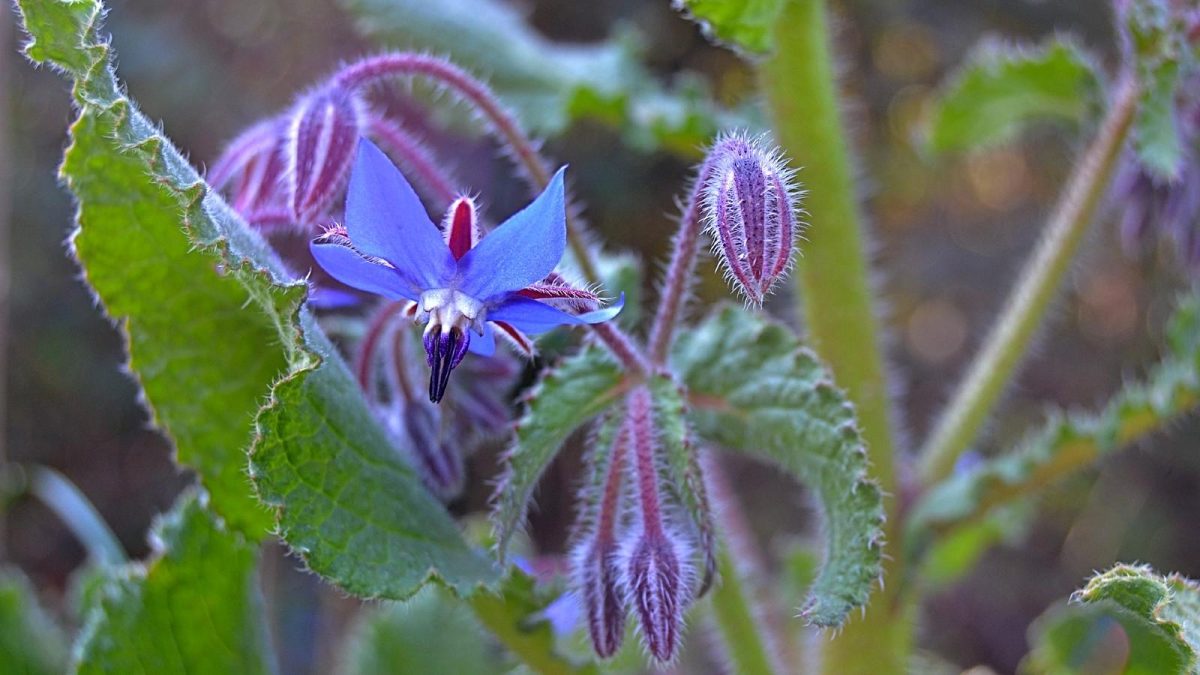By Barbara Bresler, BCMG
July 2023

Borage (Borago officianalis), also known asbee plant, or starflower is an annual herb in the flowering plant family Boraginaceae. It is well-known for its uses in preparing green sauces, garnishing salads, and adding honey to sweeten desserts.
The leaves and stems are rough and hairy, giving the plant a somewhat fuzzy look and adding interesting texture to your garden. The flower features 5 separate sepals and 5 united petals with stamens attached and 4 nutlets ( a seed covered by a stony layer). Borage is non-invasive, its flowers are a brilliant blue, and it blooms continuously. Best of all, borage leaves are edible and the plant is a great pollinator.
A native to the Mediterranean region, borage has naturalized in Europe, including Denmark, France, Germany, the United Kingdom, and Ireland. Since the plant can easily tolerate drought and grow in poor soils it can be successfully grown in the oftentimes harsh environment of south Texas.
How to Grow Borage
Borage is best started by seeds. Seed packets are widely available at nurseries and through seed catalogs. The roots have a simple structure and help aerate the soil.
- When to Plant Plant borage in the garden in the early spring after the threat of frost has passed. You can also start seeds indoors 3 to 4 four weeks before the last frost. Transplant seedlings into the garden once the soil has warmed.
- Selecting a Planting Site Select a location that receives at least 4 hours of direct sunlight. While the plants can tolerate partial shade, growing borage in full sun will produce many blooms. Borage also can be grown in containers.
- Spacing, Depth, and Support Plant seeds 1/4 to 1/2 inch deep. Thin seedlings when they are 6 to 8 inches tall and space them from 18 to 24 inches apart.

- Soil Borage can tolerate a variety of soil conditions even in dry, nutrient-poor soils. The plant prefers a moderately moist, well-drained soil. Amending your soil with organic matter such as compost, will help give your plants a nutritional boost.
- Water Once established, water borage at least every few days to keep the soil evenly moist but not soggy. Once the plant is mature, you can allow the soil to dry out between waterings.
- Temperature and Humidity Borage is a particularly hardy herb and able to withstand high and low temperatures. While it is tolerant of heat and cold weather, it is unable to withstand a hard frost.
- Fertilizer Borage plants growing in poor soil will benefit from periodic feeding with any fertilizer labeled for use on edible plants, following label instructions. Fertilizer that’s high in phosphorous will aid in flower production.
Harvest borage as it begins to flower. Once the plant has gone to seed, it is an inviting source of food for seed-eating birds and, as discussed below, has many culinary uses and nutritional advantages.
The Many Uses of Borage
In the garden, borage can be used as a fresh vegetable or a dried herb. Due to its cucumber-like flavor, the plant’s young, tender leaves are ideal in salads. Beware: as the plant ages, its leaves become tough, larger, fuzzier, and bitter in taste.
Vegetable use is common in Germany, in the Spanish regions of Aragón and Navarre, on the Greek island of Crete, and in the northern Italian region of Liguria.
- Although often used in soups, one of the better known German borage recipes is the Frankfurt specialty “green sauce.”
- In Liguria, Italy, borage (or borragine) is commonly used as a filling for ravioli.
- The plant is also used as an herb to flavor pickled gherkins in Poland and Russia.
The simple structure of the borage flower makes it easy for bees to access and to produce nectar, which makes a light and delicate honey. Because of the sweet taste, borage is often used to decorate desserts, as a garnish for cocktails, or frozen in ice cubes.
Finally, borage’s pollinator properties are a main reason why it is a great companion plant. Borage is reportedly used to protect legumes, spinach, brassicas, tomatoes and strawberries.
Borage’s Health Benefits
- Borage is a low-calorie culinary herb: 100 grams of fresh leaves contain only 21 calories. The plant also has many important nutrients, minerals, and vitamins that are important for maintaining health and wellness.
- Borage contains essential fatty acid γ -linolenic acid (GLA), an omega-6 fatty acid that plays a vital role in restoring joint health, immunity, and healthy skin.
- Borage has high levels of vitamin C (ascorbic acid), a natural anti-oxidant that helps to remove harmful free radicals from the body, is an immune booster and wound healer, and has anti-viral qualities.
- The herb is a rich source of vitamin A and carotene, both of which are strong anti-oxidants. Together, they protect users against oxygen-derived free radicals and reactive oxygen species (ROS) that play a vital role in aging and various disease processes.
The multi-use, beautiful herb would be a welcome addition to any garden. Give it a try!
Additional Resources:
Texas A&M AgriLife Extension: Growing Herbs in Texas

